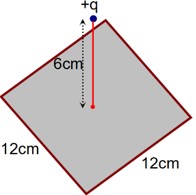1.34 Suppose that the particle in Exercise in 1.33 is an electron projected with velocity = 2.0 × 106 m s–1. If E between the plates separated by 0.5 cm is 9.1 × 102 N/C, where will the electron strike the upper plate? (|e|=1.6 × 10–19 C, me
= 9.1 × 10–31 kg.)
1.34 Suppose that the particle in Exercise in 1.33 is an electron projected with velocity = 2.0 × 106 m s–1. If E between the plates separated by 0.5 cm is 9.1 × 102 N/C, where will the electron strike the upper plate? (|e|=1.6 × 10–19 C, me = 9.1 × 10–31 kg.)
-
1 Answer
-
1.34 Velocity of the particle, = 2.0 m/s
Separation of the two plates, d = 0.5 cm = 0.005 m
Electric field between two plates, E = 9.1 N/C
Charge of an electron, q = 1.6 C
Mass of an electron, = 9.1 kg
Let the electron strike the upper plate at the end of the plate L, when deflection is s. Therefore
s =
L = = =
= 0.0158 m = 1.58 cmTherefore, the electron will strike the upper plate after travelling 1.58 cm.
Similar Questions for you
The following are the topics covered in this chapter: Electric Field and Field Lines, Gauss's Law, Electric Dipole, Conductors and Insulators, and Electric Flux.
Indeed, it is an easy chapter of Class 12 Physics. In this chapter, you will learn about the foundational concepts like Gauss's law and electric fields.
Flux through the 6 sides of square (i.e. cube)
Flux through a square
In the medical entrance test NEET, this chapter has a moderate weightage. You can expect around 2-3 questions of this chapter that contributes to the 3-5% of the total marks in the Physics section.
From Guass’s Law
Taking an Exam? Selecting a College?
Get authentic answers from experts, students and alumni that you won't find anywhere else
Sign Up on ShikshaOn Shiksha, get access to
- 65k Colleges
- 1.2k Exams
- 679k Reviews
- 1800k Answers


